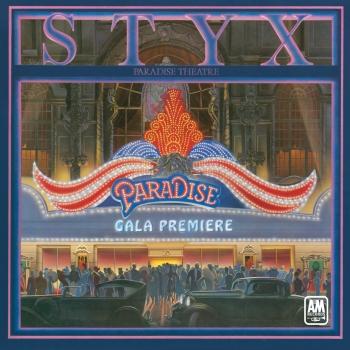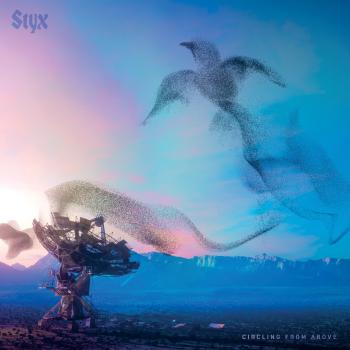
Crash Of The Crown Styx
Album info
Album-Release:
2021
HRA-Release:
18.06.2021
Album including Album cover
I`m sorry!
Dear HIGHRESAUDIO Visitor,
due to territorial constraints and also different releases dates in each country you currently can`t purchase this album. We are updating our release dates twice a week. So, please feel free to check from time-to-time, if the album is available for your country.
We suggest, that you bookmark the album and use our Short List function.
Thank you for your understanding and patience.
Yours sincerely, HIGHRESAUDIO
- 1 The Fight Of Our Lives 01:54
- 2 A Monster 03:27
- 3 Reveries 03:03
- 4 Hold Back The Darkness 03:58
- 5 Save Us From Ourselves 03:02
- 6 Crash Of The Crown 03:46
- 7 Our Wonderful Lives 03:06
- 8 Common Ground 04:00
- 9 Sound The Alarm 03:25
- 10 Long Live The King 02:33
- 11 Lost At Sea 00:38
- 12 Coming Out The Other Side 03:48
- 13 To Those 03:01
- 14 Another Farewell 00:26
- 15 Stream 02:56
Info for Crash Of The Crown
A new era of hope, survival, and prosperity comes calling with the release of CRASH OF THE CROWN, STYX's new studio album, which was written pre-pandemic and recorded during the trying times of the pandemic.
Efforts to record CRASH OF THE CROWN began in earnest at Shaw's home studio in Nashville during the fall of 2019, with Gowan — STYX's criminally minded showman extraordinaire and keyboardist/vocalist since 1999 — in the room together with Shaw and the album's producer, Will Evankovich, as he conjured up the album's first song to be recorded, with cosmetic flourishes that reign over the insistent, yearning call for togetherness, "Common Ground." But the global pandemic that inevitably transformed the way we all wound up living in 2020 changed the course for how many of the band's home-and-away recording sessions ultimately had to set socially distanced sail. Safety precautions took precedent for all involved STYX bandmembers and production compatriots with much diligent quarantining and testing required before any one of them could travel to Shaw's tranquility homebase to spread the uniquely ingrained STYX stardust that's been duly sprinkled across the album's cosmically chosen 15 tracks.
Of all those who made the trek to Nashville, original STYX bassist Chuck Panozzo — who, along with his late twin brother, drummer John Panozzo, formed the initial nucleus of STYX when they began jamming together in their basement on the south side of Chicago in 1961 — is hands down the most effusive about the experience. "I'm constantly amazed at how Tommy's songwriting continues to connect with the social consciousness that spans across generations," marvels Chuck, who plays on "Our Wonderful Lives" and "Lost at Sea," Lawrence's all-too-brief aquatic fever dream. "Both he and Will have been able to tap into the core elements of the human condition, which is something that's not going to change that much in 50 years — or even 500 years. That's why STYX remains relevant after all this time, because we're part of the human condition."
Whether it's the heady rush of the groundwork-laying opening track "The Fight of Our Lives," the wistfully observational treatise of "Reveries," the cautionary extended hand of comfort and redemption that frames "Hold Back the Darkness," the undeniable uplift of "Our Wonderful Lives" (a beautiful sentiment further embellished by a most welcome, first-ever appearance by a banjo on a STYX album!), or the elegiac clarion call for shared grace in "To Those," CRASH OF THE CROWN is music that is both concurrently of its time and truly timeless all at once. Although the official release date for this landmark album may be time-stamped as 2021, the omnisciently observational content of CRASH OF THE CROWN readily brings to mind an amalgamation of historical events that occurred in 1066, 1455, 1775, 1861, 1941, and even 2001 without citing any of them by name — Winston Churchill's prescient wartime observations that permeate the pervasive pleas of "Save Us From Ourselves" notwithstanding. In essence, CRASH OF THE CROWN (or COTC, for short) is a modern-day sonic chronograph of the endless regenerative cycle of the rise and fall — and rise again — of our shared human experience.
"We've never been a protest band. We're more like a gospel caravan trying to send out positive messages wherever we go," observes CRASH OF THE CROWN co-creator and overall visionary Tommy Shaw, who joined STYX in December 1975 as a guitarist/vocalist and instantly became one of the band's most important songwriters. "In order to share those positive messages, you have to look at what the problems are first to figure out all the ways you can help make sure everything's going to be alright. That's a very important part of how we do what we do."
Though COTC takes a hard look at some inherently dark subjects, the prevalent light at the end of the tunnel eventually becomes each song's focal point — a persistent fervor to keep moving forward and achieve the greater good.
STYX's holy mission for cutting CRASH OF THE CROWN was crystal-clear to its co-creator from the get-go. "Absolutely no obstacles were going to get in the way of how we approached creating this album," Shaw concludes about the herculean recording efforts of his fellow COTC makers. "And everything came out exactly the way we wanted to hear it."
James "JY" Young, lead vocals, guitars
Tommy Shaw, lead vocals, guitars
Chuck Panozzo, bass, vocals
Todd Sucherman, drums, percussion
Lawrence Gowan, lead vocals, keyboards
Ricky Phillips, bass, guitar, vocals
Styx
This Chicago, Illinois, USA-based quintet is widely believed to be responsible for the development of the term pomp-rock (pompous, overblown arrangements, with perfect-pitch harmonies and a very full production).
Styx evolved from the bands Tradewinds and TW4, but renamed themselves after the fabled river from Greek mythology, when they signed to Wooden Nickel, a subsidiary of RCA Records, in 1972. The initial line-up comprised Dennis DeYoung (18 February 1947, Chicago, Illinois, USA; vocals/keyboards), James Young (b. 14 November 1949, Chicago, Illinois, USA; guitar/vocals), Chuck Panozzo (b. Charles Salvatore Panozzo, 20 September 1948, Chicago, Illinois, USA; bass), John Panozzo (b. 20 September 1948, Chicago, Illinois, USA, d. 16 July 1996, Chicago, Illinois, USA; drums) and John Curulewski (b. 3 October 1950, USA, d. February 1988; guitar). Combining symphonic and progressive influences they released a series of varied and highly melodic albums during the early 70s. Success was slow to catch up with them; Styx II, originally released in 1973, spawned the Top 10 Billboard hit "Lady" in 1975. The album then made similar progress, eventually peaking at number 20.
After signing to A&M Records in 1975, John Curulewski departed with the release of Equinox, to be replaced by Tommy Shaw (b. 11 September 1953, Montgomery, Alabama, USA). This was a real turning point in the band's career as Shaw took over lead vocals and contributed significantly on the writing side. From here on Styx albums had an added degree of accessibility and moved towards a more commercial approach. The Grand Illusion, released in 1977, was Shaw's first major success, peaking at number 6 during its nine-month stay on the Billboard album chart. It also featured the number 8-peaking single, "Come Sail Away". Pieces Of Eight (1978) and Cornerstone (1979) consolidated their success, with the latter containing "Babe", the band's first number 1 single in the USA. Paradise Theatre (1981) was Styx's tour de force, a complex, laser-etched concept album, complete with elaborate and expensive packaging. It generated two further US Top 10 hits in "The Best Of Times" and "Too Much Time On My Hands". The album became their most successful ever, and also stayed at number 1 for three weeks on the US album chart. With DeYoung pushing for a more theatrical approach, Kilroy Was Here (1983) followed, yet another concept album that brought them close to repetition. A watered-down pop rock album with a big-budget production, its success came on the back of their previous album rather than on its own merits. Caught In The Act (1984) was an uninspired live offering and they disbanded shortly after its release. DeYoung and Shaw both recorded solo albums, with the former enjoying a US Top 10 hit in 1984 with "Desert Moon".
Styx re-formed in 1990 with the classic line-up, except for pop rock funkster Glenn Burtnick aka Glen Burtnik (b. USA), who replaced Tommy Shaw (who had joined Damn Yankees). Edge Of The Century indicated that the band still had something to offer, with a diverse and classy selection of contemporary AOR, including the Top 3 hit "Show Me The Way". As one of the tracks on the album stated, the band was self-evidently "Not Dead Yet". Following a US tour to promote the album, the band members once again went their separate ways. They reunited in 1995 to promote a compilation album, with Shaw back on board but without the ill John Panozzo (he passed away in 1996 due to alchohol related problems). Todd Sucherman (b. 2 May 1969, USA) became a full-time member on the Return To Paradise tour. Chuck Panozzo and Dennis DeYoung both left following the recording of Brave New World (1999), with the former announcing he was HIV positive and inter-band tension making the latter's presence no longer sustainable. DeYoung has continued to play Styx music as a solo artist. Lawrence Gowan (b. 22 November 1956, Glasgow, Scotland; keyboards/vocals) was brought in to replace DeYoung, and Burtnick returned to cover for Panozzo.
Styx has continued on the nostalgia circuit into the new millennium and continues to sell large numbers of albums, as demonstrated by the high-charting covers set Big Bang Theory in 2005. The album featured new bass player Ricky Phillips. (Source: bettyloumusic.com)
This album contains no booklet.















